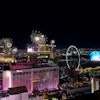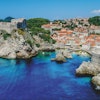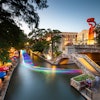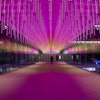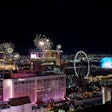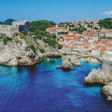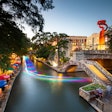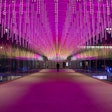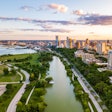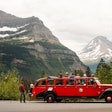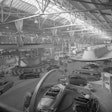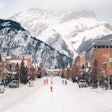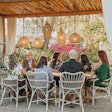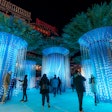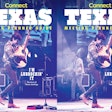From the perennial award-winning Stanley Park—a 1,000-acre oasis of civility on downtown’s edge—and the miles-long linear greenway and park that is the Vancouver seawall to the bustling Port of Vancouver and the nearby North Shore Mountains overlooking the city, Vancouver charms all who visit. Hailed as one of the world’s most livable cities, Vancouver aims to burnish its reputation to include world’s greenest city as well. The city’s Greenest City action plan is an aggressive undertaking that addresses waste, transportation, development, water usage and renewable strategies. Planners are taking notice, placing Vancouver high on their list for conferences and meetings. Here’s a peek at how Vancouver Convention Centre is getting its green on followed by our take on green-inspired city attractions for meeting participants to enjoy during their free time.
Vancouver Convention Centre
The facility, one of the largest in Canada, is the first convention center in the world to achieve double LEED Platinum certification. Two connected buildings flank a busy pedestrian plaza, offer nearly 467,000 square feet of flexible meeting space and deliver dramatic views of downtown’s shimmering waterfront. The center holds more than 500 meetings each year including the international TED Conference, hosted here annually since 2014.
- Developed in 1986 as the centerpiece to the World’s Fair Expo, the convention center is a leader in green initiatives and takes special pride in rolling out the green carpet for visiting groups. These include:
- A 6-acre living roof, the largest in Canada and the largest nonindustrial living roof in North America. More than 400,000 indigenous plants and grasses act as a building insulator, reducing heat buildup in summer and heat losses in winter. The roof is also home to four beehives with European honeybees that yield a modest supply of honey.
- A restored marine habitat is constructed into the West Building’s foundation. Visitors can watch the variety of sea life darting about from floor-to-ceiling windows facing the harbor or along the outdoor patio overhanging the man-made reef.An advanced black-water treatment plant recycles gray and black water, returning it to the facility for restrooms and rooftop irrigation.
- The center’s heating and cooling system uses the adjacent seawater to cool the building during warmer months and for heat in cooler months.
- Green initiatives extend into the center’s kitchens where fresh, local and seasonal ingredients take a starring role at meals and local sourcing contributes to less energy consumption for transportation. Food waste and scraps are also sent for composting. There is an extensive facilitywide recycling program, including organics.
Exploring Vancouver
There’s plenty for conference attendees to do, see, (and eat!) in and around Vancouver during downtime. Best of all, the city is walkable and easy to navigate. Here are our favorite green-inspired sites: Capilano Suspension Bridge Park.
Many don’t realize Vancouver is a rainforest habitat—albeit a temperate one, receiving 6 to 9 feet of rain annually. Capilano Suspension Bridge Park is a stunning example with lush greenery on display in each of the four seasons. The sprawling tree canopy, unfurling ferns and active fauna are continuously on spectacular display. Jaw-dropping views from the swaying 450-foot cedar-plank bridge suspend intrepid hikers 230 feet—more than 20 stories—above the rushing Capilano River. More than a few have dropped their cellphones midselfie, so avoid catastrophe from the safer vantage point along one of the many trails here. We recommend the Cliffwalk, with its even higher viewpoint of 300 feet and extended walkway over the gorge.
Stanley Park. This beloved park is one of the top public recreational spots in the world with more than 1,000 acres of verdant parkland, fronted by water on three sides and situated just along the edge of downtown Vancouver. Birders, joggers, families and outdoor enthusiasts find a peaceful escape from the rigors of the city in this tranquil green space. Visitors can take tours through horse-drawn carriage rides, First Nation (indigenous Canadian people) gardens and totem poles, spectacular rose gardens or simply take in the scene on a quiet bench.
Vancouver Aquarium. This loved site found inside the park grounds and offers visitors face-to-face encounters with beluga whales, sea otters, rays, sharks, 50-foot-high tanks of neon jellyfish and endless wonders of local ocean waters. University of British Columbia Botanical Garden. The vibe here is more parkland than 70-acre research site, especially when visitors embark on the 1,000-foot-long Greenheart TreeWalk. Adventurers need to hang on tight as navigation is along a network of suspended footbridges that sway considerably. Spy raptors among the massive cedars and hemlocks looking for a meal in the greenery below. Respite comes by way of eight platforms where breath-catching and snapping photos are good options.
Granville Island Public Market. Visitors should come hungry to this gastronomic touchstone, the heart and soul of Vancouver’s burgeoning foodie scene. Just-caught seafood and smoked fish, fresh produce and flowers, coffee, tea, artisanal chocolate and some of the city’s most delectable baked goods have visitors climbing aboard water taxis all day long for the short ride across False Creek at Vancouver’s West End to this bustling market. The market is host to dozens of locals-only food shops tempting all the senses. Scout out Oyama Sausage Co., charcuterie wizards and home of the special British Columbia red wine prosciutto and bison bresaola. Lee’s Donuts may put a dent in the diet, but the massive fritters (the apple-maple variety is over-the-top) and honey-dipped raised doughnuts bring back memories of Grandma’s homemade fried cakes.
FlyOver Canada. Located directly next to Vancouver Convention Centre in Canada Place on Burrard Inlet, FlyOver Canada is a heart-thumping adrenaline rush of a 4D-simulated helicopter flight over Canada. It takes visitors from the icy waters off Newfoundland through the surging drop of Niagara Falls, over Calgary’s plains and atop the Banff glacier, finally returning “passengers” back to Vancouver’s coast and into the city. After the ride, walk across the plaza to Miku and enjoy Aburi-style (blowtorch-flamed) sushi at one of the top eateries in the city.
Eco-Excursions
Conventioneeers and small groups looking to extend their West Coast Canadian visit have many opportunities for ecotours starting from Vancouver.
Snorkel with salmon in Campbell River. Each July through September, Destiny River Adventures will take your group on the Quinsam River, a tributary of Campbell River, to enjoy the Salmon Capital of the World, just off Vancouver Island’s east coast.
Walk with grizzlies in the Cariboo. Led by grizzly specialist, Ecotours-BC guide and longtime grizzly aficionado Gary Zorn, grizzly watchers wade chest-high in the river and stride among the earth’s largest predators. The Glamping with Grizzlies package and a winter adventure snowshoeing package to spot wolves, lynx and moose are also options for larger groups.
Kayak with whales off Vancouver Island. Ecosummer Expeditions leads three- to six-day Orca Camp guided kayak trips July through September in Robson Bight Ecological Reserve, aka “Orca Central” and also home to one of the world’s largest populations of dolphins. Landlubber? Take Canada’s West Coast Wildlife Safari or Orca Camp wildlife photography tour, where giant humpbacks, otters, sea lions, acrobatic Pacific white-sided dolphins and foraging grizzlies are spotted.
Explore Nimmo Bay Trout and salmon fishing is first rate here, as are whale watching, trekking and wildlife photo safaris. Get high above it all in a heli-adventure soaring over 50,000 square miles of wilderness.
